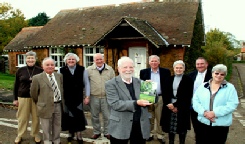
 Local Business, Food, Accommodation
History Group
Local Events
Local Business, Food, Accommodation
History Group
Local Events




 Summary of Castle Rising
Summary of Castle Rising
















The Castle at Castle Rising
The castle in the village attracts hundreds of visitors each year and is one of the most intact Norman castles in the UK. It was built around 1140, during the reign of King Steven, when there was great turmoil in England. The castle was built by William D’Albini II, one of the most powerful noblemen of the time, through his marriage to Adeliza, the widow of King Henry I. His father was the Pincerna (or butler) to William the Conqueror and had inherited the Manor of Rising during the reign of William II.
The castle was never thought of as a defensive structure, but was a symbol of D’Albini’s power and status. It is unclear why it was built at Rising, but probably the availability of Silver Carr (the best building stone in East Anglia) nearby may have influenced the choice. There was also good water access to the sea, and this was exploited by D’Albini who located his Dove-
The D’Albini family died out in 1243 and the castle and Manor passed to the Montalt family, another powerful Norman family. However the Montalts too died out in 1331, after which it came into the ownership of its most famous resident, Queen Isabella, the so-
The castle however was never repaired, and was used by subsequent Lords of the Manor mainly to provide building material for other buildings in the manor. It was for a time used by squatters who had gained access through holes that they made through the walls.
It was only in the nineteenth century that the owners gave evidence of concern for its preservation. Fulk Greville Howard and his wife Mary restored not only the castle but also the churches associated with the manor. In recent years English Heritage has carried out extensive excavation and restoration, although the castle still remains in the ownership of a branch of the Howard family.